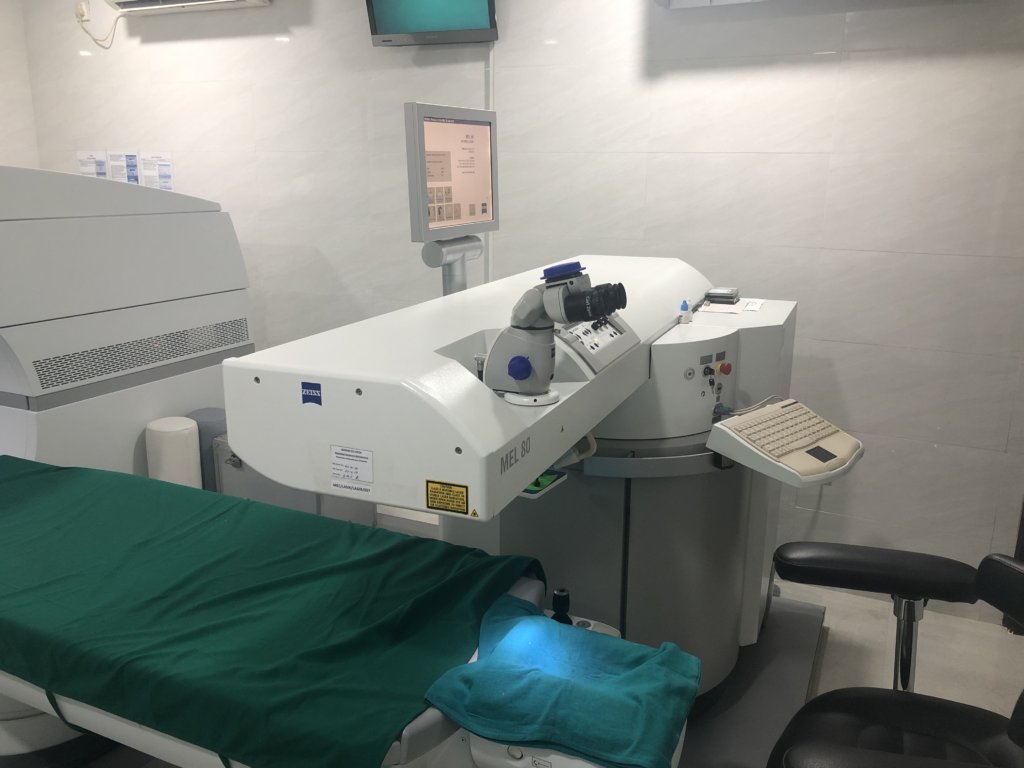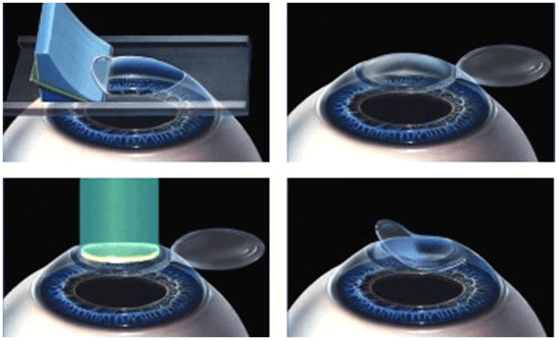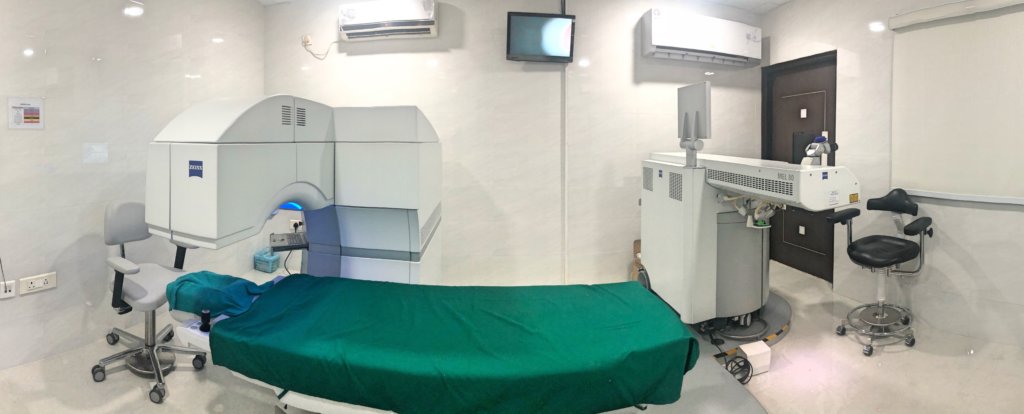The most popular refractive surgery today is LASIK, a laser vision correction procedure that improves eyesight by reshaping the front surface of the eye with an excimer laser. “LASIK” is an acronym for “laser in situ keratomileusis,” which means, “to reshape the living cornea”.
We, at MEC, perform lasik on state-of-the-art, high performance and versatile combination of Femtosecond Laser Visumax and Excimer Laser MEL 80 from world leader in opto-electronics, Zeiss. The machines are designed to make the correction of vision defects even safer, more patient-friendly and individual. All the parameters of this ultramodern work platform are oriented towards increasing efficiency, achieving optimum treatment results and the rapid recovery of vision. Key factors here are the very high ablation rate, the high-performance eye tracker system and individual treatment planning.
 Zeiss Mel 80 Excimer Laser System
Zeiss Mel 80 Excimer Laser System
Understanding LASIK
LASIK , the laser procedure permanently changes the shape of the cornea, the clear covering of the front of the eye, using an excimer laser.
 Lasik Surgery Schematics
Lasik Surgery Schematics It is a two-step procedure which begins with a hinged flap creation using a either a mechanical microkeratome (a blade device) or a laser microkeratome (Femto laser assisted bladeless procedure) . The flap is folded back revealing the stroma, the middle section of the cornea. Laser pulses from excimer vaporizes a predetermined portion of the stroma and the flap is replaced.
Range of Power Approved
Laser vision correction has been approved for myopia up to -12.00 D, hyperopia up to +6.00D and astigmatism upto 6.00 D depending upon corneal thickness and shape.
Age for Lasik
Patient should be greater than 18 years of age however a good candidate is one who has stable glasses and/or contact lens prescription. Most individuals by the age of 20-21 have reached a point at which their glasses prescription will remain relatively stable.
Pre-Lasik Workup
At MEC, we offer detailed pre-lasik workup with Detailed Patient History and Clinical Examination with Special Stress on Understanding Patient Expectations and Requirements, Eye Tear Film/ Dryness Assessment, Corneal Topography (Atlas: Humphrey, USA), Corneal Pachymetry (thickness) (Sonomed, USA), Corneal Tomography (Pentacam: Oculus, Germany) and Retinal Periphery Examination with Indirect Ophthalmoscopy.
Procedure
Throughout the procedure the patient is awake and eye drops are the only anesthesia given (Topical) making the procedure essentially painless. Patient’s eyelids and lashes are cleansed for sterility and the lids are gently opened with an eye speculum. Patients keep on looking at a blinking red light that keeps eye properly positioned. During the flap creation phase one has a sensation of pressure and a grayness of vision. Then the laser is used and one will hear a rapid clicking sound. The flap is replaced and it takes about 1-2 minutes for it to stick down. The procedure takes about 5-10 minutes per eye. After the procedure, patients will be prescribed eye drops to help your eye heal. Also, vision may be a little blurry for a day or so. Most patients are able to return to work in 24 hours, and have continuing improvement in their vision over next 3-4 weeks.L
Lasik Surgery: Step by Step
Life of Laser Correction:
The laser vision correction will generally last for the rest of your life. Current studies show that once the cornea has been modified by the current Excimer laser protocol such as LASIK, it tends to remain stable and stay modified permanently. There are rare cases of regression, which may be corrected with further surgery, but the vast majority of corrected eyes remain stable.
Femto-LASIK (Bladeless LASIK)
Femtosecond laser has revolutionized laser refractive surgery. It is a precise, cutting tool that can make corneal surgery accurate and safe.
In Femto LASIK, two lasers are used during the procedure: Corneal flap is fashioned with a femtosecond laser as a first step followed by excimer laser power correction below the flap as the next step.In Femto LASIK, the flap is created with laser instead of blade as in conventional LASIK.
 Zeiss Visumax and Mel Combination Platform at MEC
Zeiss Visumax and Mel Combination Platform at MECFEMTO VERSUS BLADE FLAP
| LASIK FLAPS: FEMTO (VS. BLADE) |
| Better Predictability of Flap Thickness: Thinner Flaps/ Lesser Ablation/ Stronger Cornea |
| Better Predictability of Flap Diameter/ Anatomy: Uniform,Smooth and Even Flaps |
| More Independent of underlying Corneal Parameters: A steep or flat cornea can pose difficulty in flap creation with microkeratome blade: Femto is Safer and Precise |
| Better anatomy of Flap edge (Vertical Cut of Femto vs. Sloping Edge of Blade Flap): Planar Flaps leading to Better Alignment and Healing with lesser chances of complications like flap displacement and epithelial cells growing under the flap edge |
| Gentler Method with Faster Vision Restoration |
| Safer and More Precise Procedure : Fewer Complications |
Frequently Asked Questions
How is bladeless Lasik better than blade Lasik?
It is a much safer procedure with lower risk of complications. The flap created is more uniform and precise . It also heals faster and better.
Are two Lasers used in bladeless Lasik?
Yes, one Femtosecond Laser is used to create the flap and another Excimer Laser is used to correct the power.
Do all Lasik Centres have bladeless option?
No, not necessarily. As it requires an entire new, expensive Laser setup different from the Excimer laser. Please ask for the bladeless Lasik option before planning your Lasik procedure
Can bladeless Lasik treat all refractive errors?
Yes, it can treat a wide range of plus, minus and cylindrical powers.
Is the pain during bladeless Lasik is lesser than with blade Lasik?
Yes, the feeling of pressure, sensation and blackout while creating the flap is associated only with the blade Lasik procedure.
After the Procedure…
- Expect to see blurry and experience some watering, irritation on the day of treatment
- The day after, vision and comfort will be better
- Care to be taken while instilling drops to not disturb the flap
- No water in the eyes and head bath for 7-8 days
- Protective sunglasses outdoors for two weeks
- Side-effects: Dryness, glare, light sensitivity, night vision blurry These are common and gradually get better over a few weeks.